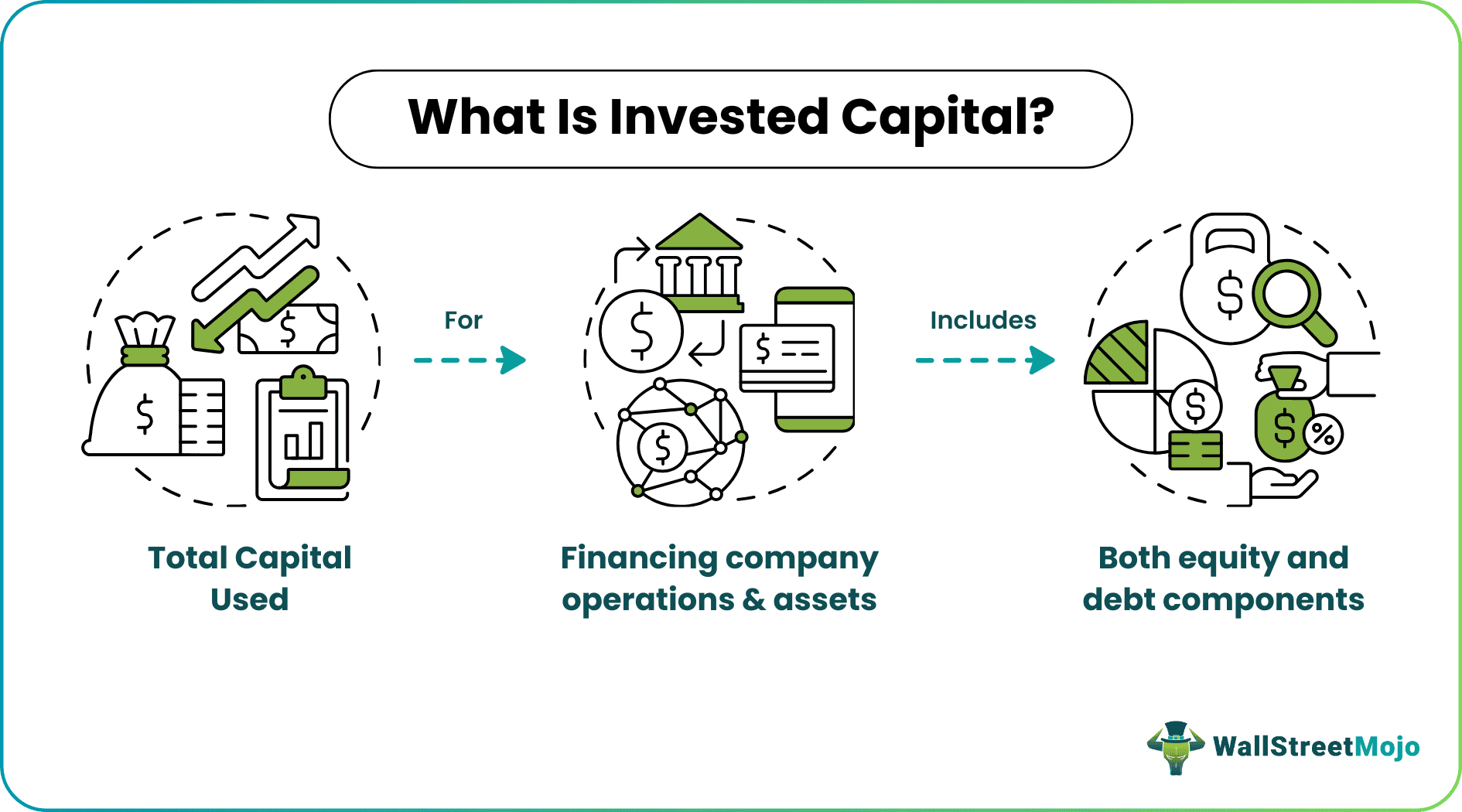Table Of Contents
Invested Capital Meaning
Invested Capital in a business refers to the total debt and equity a firm raises to finance its operations and expansion activities. A firm issues equity or preference shares to stockholders, bonds to debenture holders, and borrows from creditors or other financial sources to raise capital.

The return on invested capital (ROIC) is an appropriate metric to measure how well a firm has used the funds in operations and undertaking new projects. It is also a measure of the firm's profitability, and it affects the dividends and interest to be paid to its stakeholders.
Key Takeaways
- Invested capital in a business represents the total capital acquired through equity issuance to shareholders, bond issuance to debenture holders, and borrowing from creditors.
- It also encompasses other financial sources like retained earnings, non-operating cash, investments, and capital leases.
- The business employs this capital to fund its operations, support market expansion, facilitate product development, finance research initiatives, and other growth-oriented activities.
- Two methods, the operating and financial approaches, can be used to calculate it. The financial approach is more commonly utilized in financial analysis because it comprehensively assesses a company's capital structure.
Invested Capital Explained
Invested capital is a financial source for any business, given how capital helps companies to take up new projects, enter new markets, and develop innovative ideas. This capital is obtained through four primary sources – equity and preferred share capital from stockholders, an unsecured loan through the sale of bonds to debenture holders, a secured loan from creditors such as banks or other financial institutions, and the company's reserves or non-operating assets.
The amount of capital invested can be determined by operating or financial approaches. Here's the invested capital formula for each:
1. Operating approach
Capital Invested = Net Working Capital + Property, Plant, and Equipment + Goodwill and Intangibles
2. Financial approach
Capital Invested = Total Debt (including Capital Leases) + Total Equity (and Equivalents) + Non-Operating Cash and Investments
Here:
- Net working capital is the difference between current current liabilities and non-interest-bearing current liabilities.
- Goodwill and intangibles refer to the firm's brand reputation, copyrights, patents, etc.
- Capital leases are legal arrangements where the lessor transfers the property rights to the lessee after the lease period.
- Non-operating cash and investments are those not utilized in the company's day-to-day activities.
- The financial approach is followed more often.
ROIC assesses a company's capital efficiency. Higher ROIC translates to more dividends for shareholders. ROIC's formula involves the Net Operating Profits After Tax (NOPAT) ratio to invested capital, typically calculated as (Operating Income - Tax Expense). This metric is frequently compared to the Weighted Average Cost of Capital (WACC), representing the expected returns shareholders and creditors expect. Investors often seek an ROIC exceeding WACC, indicating returns surpassing the cost of capital.
Examples
Let us study a few examples.
Example #1
Refer to the information given below and calculate the capital invested.
Equity share capital = $100,000
Preference share capital = $20,000
Retained earnings = $30,000
Unsecured loan = $60,000
Secured loan = $90,000
Capital lease = $10,000
Non-operating cash and investments = $20,000
Total equity and equity equivalents = Equity share capital + Preference share capital + Retained earnings
= $100,000 + $20,000 + $30,000 = $150,000
Total debt and lease = Unsecured loan + Secured loan + Capital lease
= $60,000 + $90,000 + $10,000 = $160,000
Total invested capital = $150,000 + $160,000 + $20,000
= $330,000
Example #2
The S&P 500's trailing twelve-month (TTM) ROIC reached a notable milestone, hitting 10.2% in the second quarter of 2022, marking the sixth consecutive quarter of increase from the 8.6% recorded in 2021. ROIC is a crucial financial metric that assesses a company's ability to generate returns on the capital invested in its operations and projects.
It's a vital indicator for investors and analysts, reflecting a company's efficiency in utilizing its resources. Furthermore, this positive trend in ROIC is particularly noteworthy, with eight out of eleven S&P 500 sectors demonstrating year-over-year growth. This improvement is attributed to enhanced Net Operating Profit After Tax (NOPAT) margins and more efficient utilization of this capital.
Invested Capital vs Capital Employed vs Committed Capital
In financial analysis and investment, understanding the distinctions between capital employed, invested, and committed capital is essential for making informed decisions and evaluating a company's financial health.
| Basis | Invested Capital | Capital Employed | Committed Capital |
|---|---|---|---|
| Definition | Funds actively used for operations and projects. It represents capital raised and invested at a specific time. | It is the total funds invested in the company for operations. It includes capital invested, total assets, and minus current liabilities. | Funds pledged by investors, especially in venture capital and private equity. An investment for higher risk-adjusted returns. |
| Basis of Distinction | Actively utilized capital within a specific timeframe. | It encompasses Invested Capital and total assets minus liabilities. | Distinct from both Capital Employed and Invested Capital. |
| Focus | Specific time frame and active investments. | It is the broader view of all capital deployed in the business. | It is an investment from external sources for high-risk returns. |
| Application | Operational and project-specific analysis. | Comprehensive financial performance evaluation. | Investment considerations beyond traditional securities. |
| Common Usage | Business analysis, project assessments. | It is used in financial reporting and performance evaluation. | It is used in private equity and venture capital investments. |
